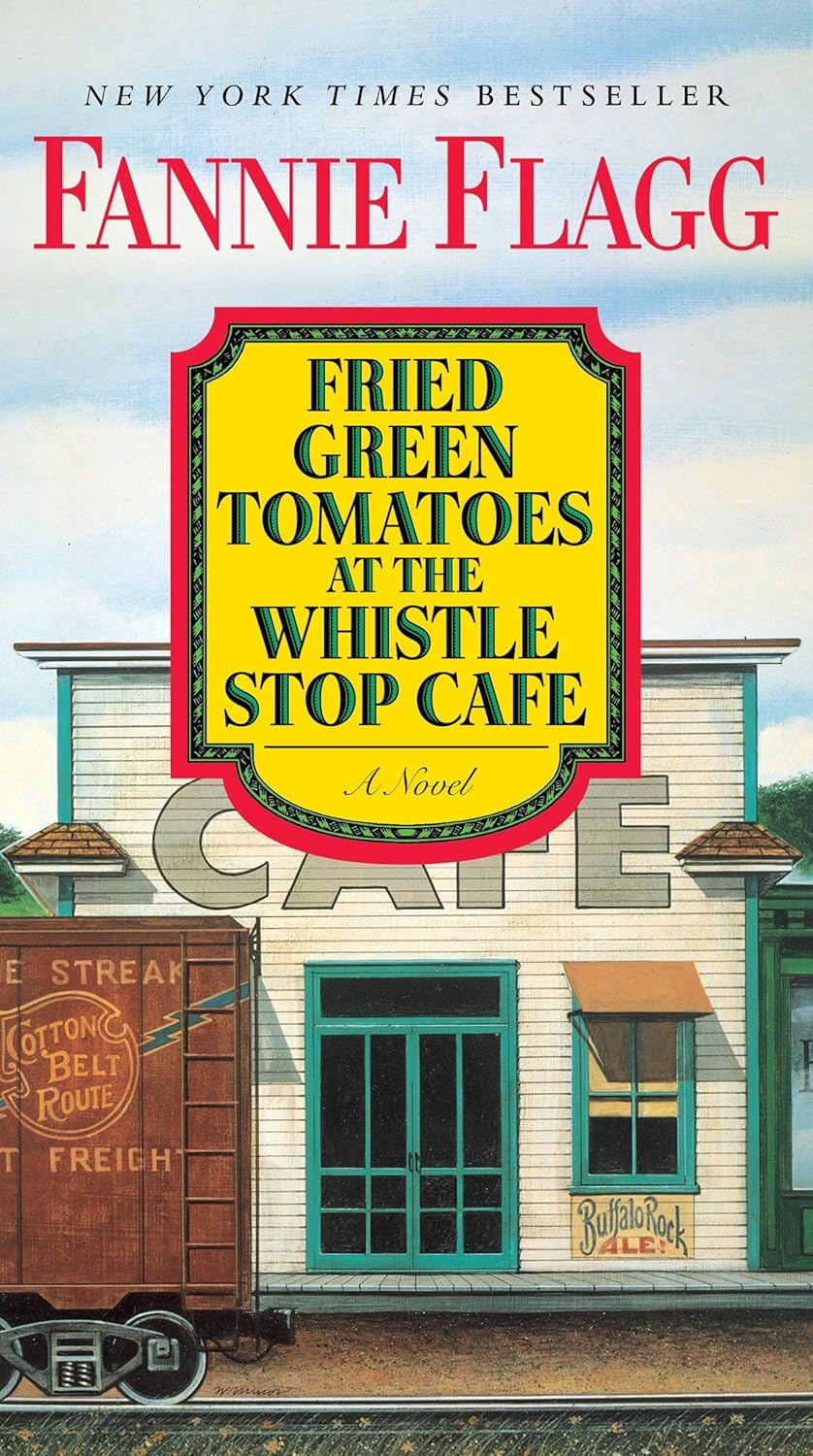Review of Fried Green Tomatoes at the Whistlestop Cafe by Fannie Flagg

Fried Green Tomatoes at the Whistlestop Cafe
Fannie Flagg
Random House, 1987, 416 pages
$9.99
Reviewed by Allison Quinlan
Growing up queer in a small Georgia town, I was always searching for glimpses of myself in the stories around me. Representation wasn’t just hard to come by—it often felt impossible, especially in a community steeped in religious traditions where queerness wasn’t something openly acknowledged, let alone celebrated. Enter the 1991 film adaptation of Fannie Flagg’s Fried Green Tomatoes at the Whistle Stop Cafe. I didn’t read the book until this year when it was kindly gifted to me, but the book and the film are quite similar.
The story deeply resonated with me as a teenager, offering a rare depiction of what I identified as sapphic love. The bond between Idgie Threadgoode and Ruth Jamison was unlike anything I’d seen on screen before. Before I watched it with my family for the first time, my mother described it as a “movie about two friends who start a café together and kill an abusive husband” (sorry for the spoiler there about the husband, but the book and movie have been out since the nineties, my friend). As soon as Idgie and Ruth interacted in the film, I already doubted they were just besties. Talk about a “historians will call them friends” moment—those women were not straight.
The novel makes their love clear. When Ruth first comes to visit the Threadgoodes, Idgie’s mother tells her siblings that Idgie has a “crush” on Ruth and that no one ought to laugh at her (81). The author describes Ruth and Idgie as “happy as anybody who is in love in the summertime can be” (87). Ruth’s description of Idgie as her “bee charmer” (87) is a sweet pet name to me—no different from calling my partner “darling.” When Ruth leaves to marry Frank, Idgie tells her she can’t go—that Ruth loves her, not him (90). It’s baffling to me that people often reduce this relationship to platonic friendship; maybe that says something about the reluctance to recognise queer love in media.
However, Fried Green Tomatoes only centres the relationship for a small portion of the work, and the work as a whole necessitates serious critique. Watching the movie as a white, queer teenager, I didn’t engage with the pretty blatant racism and focused solely on the queer relationship. There’s a lot wrong with the portrayals of Blackness. There’s a split in the book of ‘good’ and ‘bad’ white people. The ‘good’ white people could be the wikipedia entry for ‘white savior.’ Even the ‘bad’ white characters are barely and rarely bad, except Frank, who is portrayed as ‘bad’ primarily because he’s a rapist first, racist second. Grady is a member of the Ku Klux Klan (KKK), yet Idgie remains close friends with him.
The author writes Black characters as loyal servants happy with subservient positions. Ninny and Evelyn treat Black people as some sort of strange ‘other.’ Throughout the book, the descriptions of Black characters’ physical appearance, speech, and behaviors are terrible. Their appearances often directly correlate to their characters’ supposed morality (particularly how ‘light’ or ‘dark’ they were (pp. 73-75). Fried Green Tomatoes is a fictional work—any argument that the work is trying to ‘reflect reality’ is selective; remember that the book portrays an openly sapphic relationship in Alabama in the 1930s. The stances presented are of the author’s own volition. The work seemingly only considers racism to be racism when it crosses a constructed line—one that separates a KKK member from a white woman’s othering of Blackness; but both hold the same racist ideologies.
Fried Green Tomatoes gave me representation that felt personal and tangible, watching Idgie and Ruth live, love, and build a life together—raising a child, running a café, and supporting each other—gave me a lot of validation during a time when I didn’t get to see much of myself in the world around me. But Fried Green Tomatoes reiterates a narrative of whiteness and white saviourism that we cannot and should not ignore. I encourage you to read “Fried Green Tomatoes at the Whistle Stop Cafe aka A Little Old Lady’s Charming and Sweet and Racist Memoir” by Marcie Alvis Walker for a more pointed explanation of the issues, with text examples, in the book and film.
For those considering reading Fried Green Tomatoes because it’s a southern lesbian classic, I would urge you to explore and invest your time and money in a different sapphic classic—one that doesn’t downplay racism or pretend colorblindness is a viable form of anti-racism. You can find a post here by Katrina Jackson about some great queer romance recommendations. If you’re interested in reading explicitly southern queer love stories, I’m working my way through Black. Queer. Southern. Women.: An Oral History by E. Patrick Johnson and like it so far, but if you’re looking for something a little more story-like, you may like Johnson’s Honeypot: Black Southern Women Who Love Women.
Allison Quinlan (they/she) works in the UK non-profit sector. They enjoy a good duck-watching session on weekends and a nice oat milk latte.
"Empowerment comes from ideas."
― Charlene Carruthers
"Your silence will not protect you."
— Tourmaline
"Gender is the poetry each of us makes out of the language we are taught."
— Leila Raven


